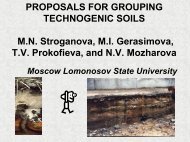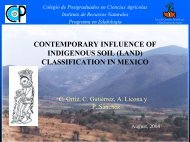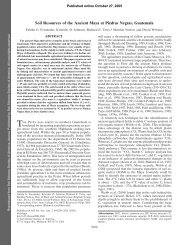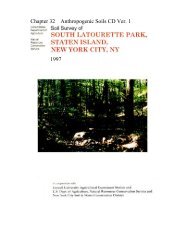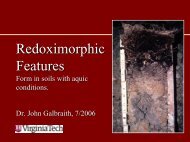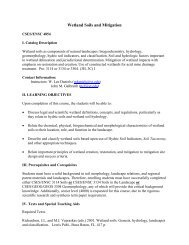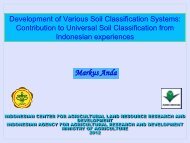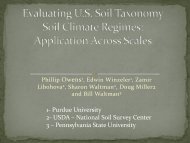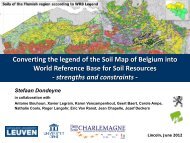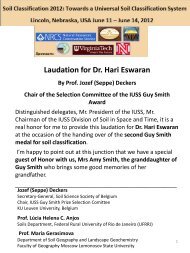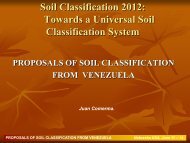4th IUSS Soil Classification Conference <strong>Field</strong> Tour Guidebook Soil and Landscape Development of the <strong>Soils</strong> of the Missouri River Floodplain The Missouri River Valley in Eastern <strong>Nebraska</strong> and Western Iowa consists of three distinct geomorphic regions; the three are not always present at specific locations. The geomorphic regions are: the channel belt which consists of bar and channel topography and braided stream remnants, the meander belt which is a floodplain step that consists of meander scrolls and splays and abandon oxbows, and the flood basin which consists of a natural levee and backswamp area which has upland steam channels snaking across it (fig. 1). Figure 1.—Overview of the relationship between parent materials and position on the Missouri River flood plain. The channel belt is the area adjacent to the Missouri River (fig. 2). It is nearly continuous from north to south. It includes the area thought to have been occupied by the Missouri River within about the last 100 years. This area was frequently flooded with 2 to 3 meters of water before the construction of dams on the Missouri River. Figure 2.—The relationship of the major soils to parent material and position in the bar area of the Missouri River flood plain 64
4th IUSS Soil Classification Conference <strong>Field</strong> Tour Guidebook The Army Corps of Engineers built dams upstream on the Missouri River in South Dakota and North Dakota to control downstream flooding. These dams were completed in 1955. Since that time the only remaining frequently flooded areas are chutes, low swales, and other low areas adjacent to the Missouri River. Because of the dams, the flooding frequency of the soils in the bar area is now rated as occasional. There are no farmsteads in the bar area, but a few vacation cabins have been built in recent years. Some of the soils in this area are the occasionally flooded phases of Albaton and Percival soils. Taxonomically the soils in this area consist of Entisols that range in particle-size class from mixed to fine and from excessively well drained to poorly drained. Sarpy Mixed, mesic typic Udipsamments Kenmoor Sandy over clayey, mixed, superactive, calcareous, mesic, Oxyaqic Usdipsamments Morconick Sandy, mixed, mesic Mollic Udifluvents Wathena Sandy, mixed, mesic Mollic Udifluvents Carr Coarse-loamy, mixed, superactive, calcareous, mesic Typic Udifluvient Waubounsie Coarse-loamy over clayey, mixed, superactive, mesic Fluventic Hapludolls Haynie, Coarse-silty, mixed, superactive, calcareous, mesic Mollic Udifluvents Grable Coarse-silty over sandy or sandy-skeletal, mixed, superactive, calcareous, mesic Mollic Udifluvents Modale Coarse-silty over clayey, mixed, superactive, calcareous, mesic Aquic Udifluvents Rodney Fine-silty over clayey, mixed, superactive, calcareous, mesic Mollic Fluvaquents Blake Fine-silty, mixed, superactive, calcareous, mesic Aquic Udifluvents Lossing Fine-silty, mixed, superactive, calcareous, mesic Aquic Udifluvents Scroll Fine-silty over sandy or sandy-skeletal, mixed, active, calcareous, mesic Aquic Udifluvents Vore Fine-silty over sandy or sandy-skeletal, mixed, superactive, calcareous, mesic Aquic Udifluvents Onawa Clayey over loamy, smectitic over mixed, superactive, calcareous, mesic Aquertic Udifluvents Percival Clayey over sandy or sandy-skeletal, smectitic over mixed, calcareous, mesic Aquic Udifluvents Albaton Fine, smectitic, calcareous, mesic Vertic Fluvaquents The meander belt is the area between the channel belt and the flood basin (fig. 3). The Missouri River occupied channels in this area during the past 100 to 300 years. As the river meandered, meander loops and channels were abandoned. Some of the loops and channels were partly filled by deposition during later flooding. Most of the area in the meander belt was covered with floodwater during the flood of 1952. Some areas of Haynie, Blake, and Modale soils were not flooded because they are at the higher elevations. Because of the dams on the Missouri River, the flooding frequency of the some soils on the young bottom land is now rated rare. Many of the same soils are mapped both in the bar area and on the young bottom land. These soils are identified on the soil maps with different map unit symbols because of the difference in flooding frequency. Also, the soils on the young bottom land tend to be somewhat less stratified than the corresponding soils in the channel belt (fig 4). Taxonomically the soils in this area consist of Entisols and a few Fluventic Mollisolls ranging from coarsesilty to fine particle-size class and well drained to poorly drained. Haynie, Coarse-silty, mixed, superactive, calcareous, mesic Mollic Udifluvents Waubounsie Coarse-loamy over clayey, mixed, superactive, mesic Fluventic Hapludolls Grable Coarse-silty over sandy or sandy-skeletal, mixed, superactive, calcareous, mesic Mollic Udifluvents Modale Coarse-silty over clayey, mixed, superactive, calcareous, mesic Aquic Udifluvents Rodney Fine-silty over clayey, mixed, superactive, calcareous, mesic Mollic Fluvaquents Blake Fine-silty, mixed, superactive, calcareous, mesic Aquic Udifluvents Lossing Fine-silty, mixed, superactive, calcareous, mesic Aquic Udifluvents Vore Fine-silty over sandy or sandy-skeletal, mixed, superactive, calcareous, mesic Aquic Udifluvents 65



